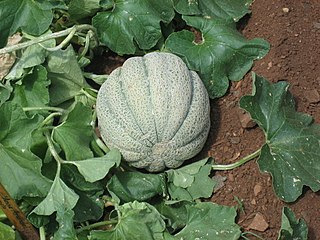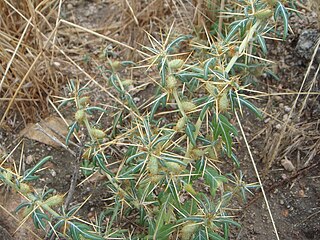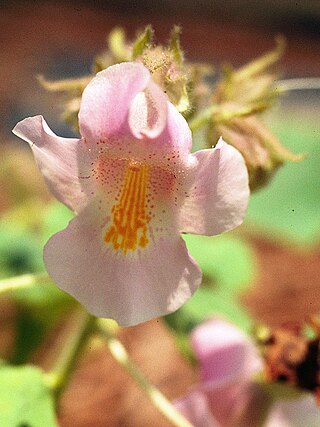Related Research Articles

The Cucurbitaceae, also called cucurbits or the gourd family, are a plant family consisting of about 965 species in around 95 genera. Those most important to humans are the following:

The cantaloupe is a type of true melon from the family Cucurbitaceae. Originally, cantaloupe referred only to the non-netted, orange-fleshed melons of Europe, but today may refer to any orange-fleshed melon of the C. melo species, including the netted muskmelon which is called cantaloupe in North America, rockmelon in Australia and New Zealand, and spanspek in Southern Africa. Cantaloupes range in mass from 0.5 to 5 kilograms.

The cucumber is a widely-cultivated creeping vine plant in the family Cucurbitaceae that bears cylindrical to spherical fruits, which are used as culinary vegetables. Considered an annual plant, there are three main types of cucumber—slicing, pickling, and seedless—within which several cultivars have been created. The cucumber originates in Asia extending from India, Nepal, Bangladesh, China, and Northern Thailand, but now grows on most continents, and many different types of cucumber are grown commercially and traded on the global market. In North America, the term wild cucumber refers to plants in the genera Echinocystis and Marah, though the two are not closely related.

A melon is any of various plants of the family Cucurbitaceae with sweet, edible, and fleshy fruit. The word "melon" can refer to either the plant or specifically to the fruit. Botanically, a melon is a kind of berry, specifically a "pepo". The word melon derives from Latin melopepo, which is the latinization of the Greek μηλοπέπων (mēlopepōn), meaning "melon", itself a compound of μῆλον (mēlon), "apple", treefruit " and πέπων (pepōn), amongst others "a kind of gourd or melon". Many different cultivars have been produced, particularly of cantaloupes.

Weed control is a type of pest control, which attempts to stop or reduce growth of weeds, especially noxious weeds, with the aim of reducing their competition with desired flora and fauna including domesticated plants and livestock, and in natural settings preventing non native species competing with native species.

Cucumis is a genus of twining, tendril-bearing plants in the family Cucurbitaceae which includes the cucumber, true melons, the horned melon, and the West Indian gherkin.

Cucumis metuliferus, commonly called the African horned cucumber, horned melon, spiked melon, jelly melon, or kiwano, is an annual vine in the cucumber and melon family Cucurbitaceae. Its fruit has horn-like spines, hence the name "horned melon". The ripe fruit has orange skin and lime-green, jelly-like flesh. C. metuliferus is native to Southern Africa, in South Africa, Namibia, Botswana, Zambia, Zimbabwe, Mozambique, and Angola.

Chayote, also known as mirliton and choko, is an edible plant belonging to the gourd family, Cucurbitaceae. This fruit was first cultivated in Mesoamerica between southern Mexico and Honduras, with the most genetic diversity available in both Mexico and Guatemala. It is one of several foods introduced to the Old World during the Columbian Exchange. At that time, the plant spread to other parts of the Americas, ultimately causing it to be integrated into the cuisine of many Latin American nations.

Cucumis anguria, commonly known as maroon cucumber, West Indian gherkin, maxixe, burr gherkin,cackrey, and West Indian gourd, is a vine that is indigenous to Africa, but has become naturalized in the New World, and is cultivated in many places. It is similar and related to the common cucumber (C. sativus) and its cultivars are known as gherkins.

Sida rhombifolia, commonly known as arrowleaf sida, is a perennial or sometimes annual plant in the Family Malvaceae, native to the Old World tropics and subtropics. Other common names include rhombus-leaved sida, Paddy's lucerne, jelly leaf, and also somewhat confusingly as Cuban jute, Queensland-hemp, and Indian hemp. Synonyms include Malva rhombifolia. It is used in Ayurvedic medicine, where it is known as kurumthotti.

The Armenian cucumber, Cucumis melo var. flexuosus, is a type of long, slender fruit which tastes like a cucumber and looks somewhat like a cucumber inside. It is actually a variety of true melon, a species closely related to the cucumber. It is also known as the yard-long cucumber, snake cucumber, snake melon, chanbar in Persian, tirozî in Kurdish, sheng in Semnani, uri in Japanese, acur in Turkish, kakadee in Hindi, tar in Punjabi, طرح in Arabic, commarella or tortarello in Italian. It should not be confused with the snake gourds. The skin is very thin, light green, and bumpless. It has no bitterness and the fruit is almost always used without peeling. It is also sometimes called a gutah.

Solanum muricatum is a species of evergreen shrub native to South America and grown for its sweet edible fruit.

Cucumis myriocarpus, the gooseberry cucumber, gooseberry gourd, paddy melon, Mallee Pear or prickly paddy melon is a prostrate or climbing annual herb native to tropical and southern Africa. It has small, round, yellow-green or green-striped fruit with soft spines, small yellow flowers and deeply lobed, light green leaves. The melon occurs in disturbed soil and cleared or bare areas, and thrives on summer moisture.

Melothria scabra, commonly known as the cucamelon, Mexican miniature watermelon, Mexican sour cucumber, Mexican sour gherkin, mouse melon, or pepquinos, is a species of flowering plant in the cucurbit family grown for its edible fruit. Its native range spans Mexico to Venezuela. Cucumis melo Agrestis and Cucumis callosus is cultivated as Chibber Fruit or Kachri in South Asia and can also grow as weed. Fruits are about the size of grapes and taste like cucumbers with a tinge of sourness. It may have been eaten by indigenous peoples before the European colonization of the Americas began.

Cucumis melo, also known as melon, is a species of Cucumis that has been developed into many cultivated varieties. The fruit is a pepo. The flesh is either sweet or bland, with or without a musky aroma, and the rind can be smooth, ribbed, wrinkled, or netted. In North America, the sweet-flesh varieties are often collectively called muskmelon, including the musky netted-rind varieties and the inodorous smooth-rind varieties, and cantaloupe usually refers to the former type. However, muskmelon in a narrow sense only refers to the musky netted-rind type, also known as North American cantaloupe, while the true cantaloupe is the European type with ribbed and often warty rind that is seldom grown in North America.

Xanthium spinosum is a species of flowering plant in the aster family known by many common names, including spiny cocklebur, prickly burweed and Bathurst burr. This species is part of the genus Xanthium that encompasses 25 different species of flowering plants of the daisy family, Asteraceae, and sunflower tribe.
Wild melon is a common name used for several species of plants in the melon family (Cucurbitaceae) which grow outside of cultivation

Proboscidea louisianica is a species of flowering plant in the family Martyniaceae. Its true native range is unclear, but probably includes parts of the southwestern United States and Mexico in North America. It occurs in other areas, including other regions in North America, Europe, Australia, and South Africa, as an introduced species. It is the most widely distributed species in its family. Common names it shares with other Proboscidea species include devil's claw and unicorn-plant. Names more specific to the species include common devil's claw, ram's horn, aphid trap, Louisiana unicorn-plant, purple-flowered devil's-claw, goat's head, and elephant tusks.

The oriental melon, is a group of Cucumis melo cultivars that are produced in East Asia. Phylogenetic studies tracing the genetic lineage of the plant suggest that it may have originated in eastern India, having then spread to China over the Silk Road, from which it was introduced to Korea and Japan. Its flavour has been described as a cross between a honeydew melon and a cucumber. It is noticeably less sweet than Western varieties of melon, and consists of about 90% water. The fruits are commonly eaten fresh; with its thin rind and small seeds, the melon can be eaten whole.
References
- ↑ "Weeds of Western Australia - Paddy melon (Cucumis myriocarpus Naud.)". Journal of Department of Agriculture. 8 (Western Australia, Series 3): 321–323. May 1958.
- ↑ Shaik, Razia S.; Burrows, Geoffrey E.; Urwin, Nigel A. R.; Gopurenko, David; Lepschi, Brendan J.; Weston, Leslie A. (2017-02-01). "The biology and management of prickly paddy melon (Cucumis myriocarpus L.), an important summer annual weed in Australia". Crop Protection. 92: 29–40. doi:10.1016/j.cropro.2016.10.005. ISSN 0261-2194.